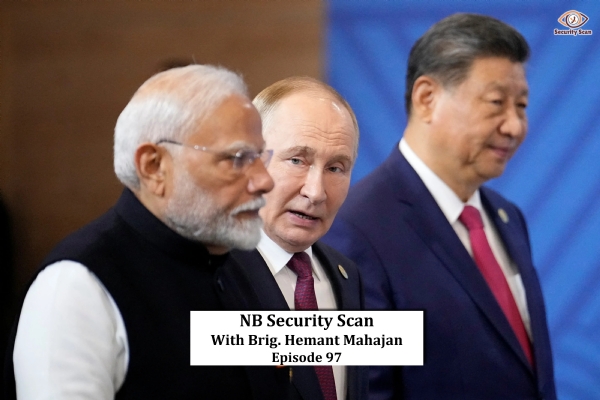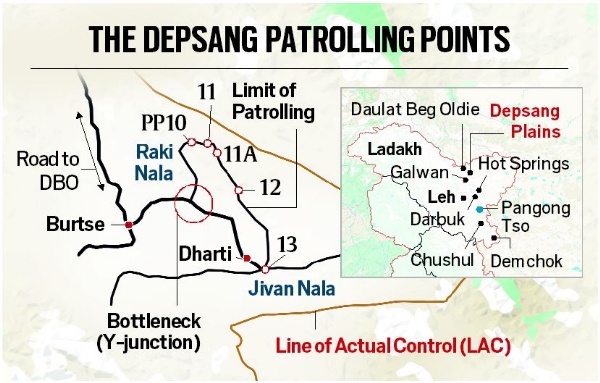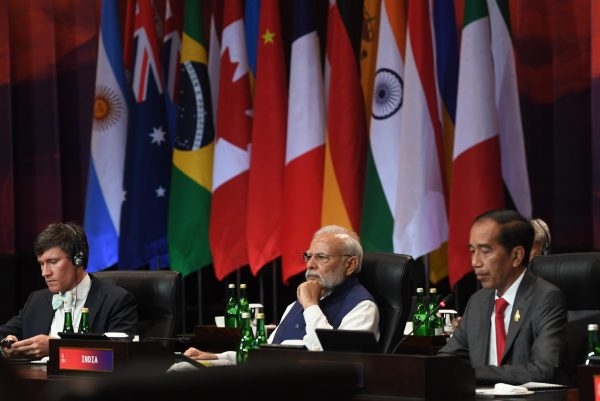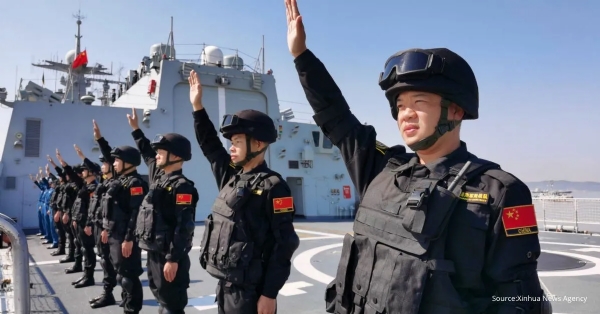#SecurityScan 97: India China Border Agreement, Restoring peace & more
04 Nov 2024 17:31:43
This article is a summary of important events that have taken place in last one week affecting, India's national security .
INDIA CHINA BORDER AGREEMENT :
IMPORTANT STEP TOWARDS RESOLVING BORDER ISSUE
India and China Resume Verification Patrols in Eastern Ladakh

India and China have resumed verification patrols in Ladakh’s Demchok and Depsang regions following an agreement reached on October 21, 2024. This move marks the end of a four-year military standoff along the Line of Actual Control (LAC) in eastern Ladakh.
Verification Patrols Begin in Demchok and Depsang
On 01 Nov24, verification patrols began in the Demchok area, shortly after Indian and Chinese troops completed disengagement efforts. Patrolling operations are also underway in Depsang, the second key friction point in the region. MEA spokesperson stated that these verification patrols are proceeding under mutually agreed terms, which were established in recent talks. The initiation of these patrols is a significant step.
Restoring Peace and the Pre-2020 Status Quo
The current disengagement process is viewed towards restoring the pre-2020 status quo ante along the LAC. Both India and China emphasized the importance of maintaining peace and stability at the border, stressing that mutual trust, respect, and sensitivity are essential foundations for their bilateral relationship. Prime Minister Modi reiterated that peace in the border areas is crucial for normalizing India-China relations.
'India, China pull back troops to pre-2020 positions as part of LAC pact
India and China have completed pulling back their troops from two face-off points at Demchok and Depsang in eastern Ladakh on 30 Oct 24. Troops of both countries have fallen back to their pre-April 2020 positions after dismantling their temporary posts, sheds, tents and other structures erected in the two areas. A thorough verification process, including on-ground inspection and surveillance through unmanned aerial vehicles (UAVs), has confirmed the complete pullback by both sides. Exchange of sweets on Diwali took place on 31 Oct.
Diplomatic Achievements and Reactions
India and China have reached a significant agreement on mutual patrolling arrangements along the Line of Actual Control (LAC) in eastern Ladakh. India has maintained a firm stance on restoring pre-2020 positions along the LAC.
External Affairs Minister S. Jaishankar described the pact as "a product of very patient and persevering diplomacy" and expressed hope for the restoration of peace along the LAC, highlighting its importance for advancing broader bilateral relations. China's response has also been positive, with Foreign Ministry spokesperson confirming progress and China’s commitment to effective implementation of the agreement.
Clash in Galwan & Standoff in Eastern Ladakh
In May 2020, Chinese People's Liberation Army (PLA), intruded into five areas traditionally claimed and patrolled by the Indian Army in eastern Ladakh. This incursion led to a deadly clash with casualties on both sides, resulting in a prolonged standoff that persisted for over four years. The situation necessitated Indian armies significant rebalancing of troops from Pak front and reinforcement of troops and weaponry in Ladakh.
Aim of this article is to carry out detailed assessment of the “India China Border Agreement”. Following aspects will be covered:-
- Significance of Demchok and Depsang
- Key Details of the India-China Patrolling Agreement
- A Positive Shift in India-China Relations
- China’s Messaging and India's Response
- China's Reasons for Concessions on the Border Dispute
- Lessons from the Doklam Crisis
- India-China Agreement on LAC: Challenges Remain-
- The Economic Dimension in India-China Relations
- Future Forecast
Significance of Demchok and Depsang
Demchok: Located near the southern LAC in Ladakh, Demchok is close to strategic infrastructure routes like the Darbuk-Shyok-Daulat Beg Oldie (DSDBO) Road. This area has long been contested, as it was a site of conflict in 1962 and remains sensitive due to its proximity to important Indian infrastructure.

Depsang: Positioned in the northwest of Ladakh near the Karakoram Pass, Depsang provides a critical access route to key military infrastructure for India. Its terrain allows easy movement for both troops and vehicles, enhancing its strategic importance.
The new patrolling agreement restores rights for the PLA as well, addressing restrictions in the Depsang Bulge and CNN Junction that followed the 2020 incursions. Buffer zones in areas like Galwan, Gogra-Hot Springs, and Pangong Tso have already helped in reducing tensions.
Enhanced Coordination and Patrolling Protocols
New patrolling protocols have been established, emphasizing mutual notification prior to patrols. Both sides have agreed to these arrangements, focusing on the size and frequency of patrol groups depending on the patrol distance and objective. For shorter-range patrols, groups will consist of 10-15 soldiers, while longer-range patrols will involve 20-25 soldiers.
Under the newly agreed “patrolling arrangements” for Depsang and Demchok, the Chinese Army will also notify Indian counterparts before initiating any patrols.
Key Details of the India-China Patrolling Agreement
Restoration of Patrolling and Grazing Rights: The recent agreement restores patrolling and grazing rights at specific points: Patrolling Points (PPs) 10, 11, 11A, 12, and 13 in Depsang, along with the Charding Ninglung Nullah area, previously occupied by Chinese troops. These areas had been significant points of tension along the Line of Actual Control (LAC) in Eastern Ladakh.
In addition to these areas, previous disengagement locations such as PP 14 (Galwan Valley), PP 15 (Hot Springs), PP 17A (Gogra), and both the northern and southern banks of Pangong Tso continue to maintain buffer zones. These buffer areas, situated largely on territory claimed by India, will remain non-patrolling zones under the current agreement.
Significance of the Agreement: This agreement, reached after nearly 20 months of negotiations, represents a significant diplomatic achievement. Securing patrolling rights in these “legacy” areas — long considered sensitive by China — reflects India’s commitment to holding firm in negotiations and sustaining diplomatic and military pressure. The persistence required to secure this agreement, particularly in two of the final unresolved points from the 2020 standoff, highlights India’s steadfast approach in the face of challenges.
A Positive Shift in India-China Relations
India Compels Rare Flexibility from China: The recent agreement on patrolling in the Depsang Plains and Demchok region highlights an unusual concession from China, which rarely retracts its aggressive military stances. In other areas, such as the South China Sea, China has firmly established military control over disputed territories. However, India’s firm stance in eastern Ladakh has demonstrated that resilience, strategic positioning, and tough negotiations can be effective.
Key Objectives of the Patrolling Agreement: The newly established patrolling agreement provides India access to approximately 650 sq km in the Depsang Plains, as well as two critical patrolling points in Demchok. Additionally, the agreement allows local herders access to grazing areas that had been previously restricted. This represents a diplomatic success for India.
A Diplomatic Victory for India: India’s successful negotiation on the patrolling agreement signals a potential thaw in relations with China, capped off by a significant meeting between Prime Minister Narendra Modi and Chinese President Xi Jinping. This bilateral dialogue, the first in five years, took place on the sidelines of the BRICS Summit in Kazan, Russia, further solidifying the progress. During the meeting, both leaders acknowledged the need for “peaceful and stable” ties, emphasizing the importance of mutual respect and maturity in bilateral relations.
Modi and Xi: A Long-Awaited Dialogue Meeting between Modi and Xi is a significant milestone following years of strained relations after the 2020 Galwan Valley clash. Although the two leaders have crossed paths at multilateral forums, this bilateral dialogue in Kazan is the first formal discussion since 2019.
The USA Angle: India faces unique challenges in its foreign relations, particularly regarding the United States, which has recently been at odds with India over issues like oil purchases from Russia and security concerns involving Gurpatwant Singh Pannun. Our relationship with USA is important and substantive.
We simply do not want it to be like other American allies wherein US takes us for granted. We will follow our interests.
China’s Subtle Messaging and India's Response
Modi’s Emphasis on “Three Mutuals” Prime Minister Modi’s insistence on the principles of “Mutual Trust, Mutual Respect, and Mutual Sensitivity” highlights India’s concerns about China’s unreciprocated approach to resolving the border dispute. While China appears content with symbolic gestures, India insists that genuine progress requires a foundation of reciprocal respect and trust.
Reluctance for Major Concessions
China’s position appears clear — it prefers the border dispute to remain secondary, not central, in diplomatic dealings.

Despite recent progress in disengagement, China’s actions indicate reluctance to make significant concessions on India’s terms. China avoids mentioning “multipolar Asia” and instead focuses on “multipolar world and greater democracy in international relations,” underscoring its desire to project itself as the dominant regional power, setting the terms for regional ties. China’s statement even hints at a condescending tone, reinforcing its self-image as Asia’s leading power.
China’s Regional Ambitions: Unipolar Asia, Multipolar World
China’s strategy towards India reflects its broader geopolitical aims. Internationally, China advocates for a multipolar world order, which would reduce U.S. dominance. However, within Asia, China appears determined to enforce a unipolar structure with itself at the center. For India, a cautious “trust but verify” approach seems prudent, balancing diplomatic engagement with the reality of ongoing territorial disputes. The future of this approach may hinge on China’s willingness to honour agreed patrolling limits along the LAC.
China's Reasons for Concessions on the Border Dispute
De-escalation at the Border: A Diplomatic Win What once seemed like an intractable and volatile standoff, saw a dramatic de-escalation. Many viewed this as a diplomatic ‘win’ and a testament to India’s resilience in facing Chinese aggression.
Global Stakes for Xi Jinping and Modi’s Participation: One key factor influencing China’s decision may have been the stakes surrounding Prime Minister Modi’s involvement in a significant non-Western global platform. China, with its ambitions to challenge the US-led global order and promote a multipolar world, found itself needing India’s participation to legitimize the summit’s success. For Xi, having India, a major power and foundational member, withdraw could reflect poorly on his strategic vision for global leadership.
Domestic Pressures in China and Border Costs: China’s recent concessions likely also reflect its pressing internal challenges. Beijing’s slowing economy and the considerable expense of maintaining a militarized border may have prompted reconsideration. Additionally, India’s deepening strategic and military relationship with Washington and the expanding Indo-US defense trade are developments China cannot ignore.
Regional Dynamics: Pakistan’s Decline and CPEC Troubles Another factor may be the instability within Pakistan, traditionally an ally of China. As Pakistan grapples with economic and political crises, it has struggled to deliver on the China-Pakistan Economic Corridor (CPEC), Xi’s flagship project, and to ensure the safety of Chinese workers, frequently targeted by extremist groups. Frustrated by Pakistan’s challenges, China’s focus appears to be shifting toward stability rather than strictly maintaining the ‘status quo ante.’
Lessons from the Doklam Crisis
It must be understood that China has indulged in these so called climbdowns at least twice in the past before important summit meetings of the SCO or the BRICS.
The Doklam military standoff in 2017 lasted for three months and ended shortly before Prime Minister Narendra Modi’s visit to Xiamen, China, where Chinese President Xi Jinping was hosting the ninth BRICS summit. This standoff saw a temporary de-escalation as Beijing pulled back its troops.
However, within a year, China discreetly redeployed forces and constructed permanent infrastructure in the contested Doklam Valley, altering the strategic landscape and establishing “facts on the ground” that shifted the status quo.
Insights for Current Disengagement at Depsang Plains and Demchok
The Doklam experience provides critical lessons for India as it navigates the current disengagement at Depsang Plains and Demchok. The 2017 crisis underscored the importance of sustained vigilance even after a negotiated resolution, as disengagement does not always equate to lasting de-escalation. The timing of the recent disengagement process, coinciding with yet another diplomatic summit, should prompt India to maintain heightened surveillance and caution along the border.
India-China Agreement on LAC: Challenges Remain-FM

Indian Military’s Role in LAC Stabilization: Jaishankar commended the Indian military’s resilience in enduring challenging conditions at the LAC. He noted that India’s enhanced border infrastructure has been pivotal in this effort, with five times more resources allocated annually compared to a decade ago. This infrastructure boost has fortified India’s position, contributing to the progress achieved thus far.
Army Chief’s Perspective: Building Trust Along the LAC
The Army Chief, General Upendra Dwivedi, has emphasized the importance of “building trust” in relations with China along the Line of Actual Control (LAC). This approach, while cautious, is grounded in practical concerns. Whether China has genuinely committed to disengagement will become clearer by next summer, when more comprehensive patrolling can resume. General Dwivedi further highlighted the need for both countries to avoid encroachments into buffer zones, suggesting that trust-building must precede the more challenging phases of disengagement, de-escalation, and eventual troop withdrawal.
Buffer Zones: Legacy of the Galwan Clash
The concept of buffer zones along the LAC emerged after the Galwan Valley clash, establishing demilitarized areas at five key friction points where both sides agreed to limited disengagement. By September 2022, these zones were largely stabilized. However, the arrangement also restricted Indian troops from accessing areas they had routinely patrolled before the Galwan incident. For meaningful progress, the dismantling of buffer zones in contested sectors and a verified return to pre-Galwan patrolling protocols are crucial prerequisites. Only then can de-escalation and de-induction move forward.
Future Forecast
India must forever be wary of Xi’s China, and work on reducing critical gaps in national power. India must confront some hard truths to protect itself from falling for another Chinese trap.
We may imagine the India-China relationship as one of equals but there’s a huge skew in the national power of the two countries. China’s economic size is $18.5tn. India’s is $3.8tn. Beijing’s defence budget for 2024 is $236bn. India’s is $75bn. In other words, the difference in size matters. And an expansionist, hyper-nationalist China under Xi can easily turn that size into bullying tactics as and when it suits Beijing.
Chinese naval muscle: China has the largest navy in the world today. And it continues to churn out naval vessels at a fast clip. Consider submarines. Chinese navy has 60 nuclear and conventional diesel-electric submarines. India has just two nuclear and 16 diesel-electric submarines. The gap has to be reduced.

Tech dominance: Beijing’s dominance in critical technologies is a serious problem for India. China is a global leader in batteries, accounting for 70-90% of the world market in lithium-ion batteries across their entire value chain. Which means at this rate, all of India’s EVs and even India’s green transition plans will hinge on Chinese batteries. This presents a serious security issue for India. Even on semiconductors for which GOI is now trying to set up indigenous production – the first chip fab is coming up in Gujarat as a joint project between the Tatas and Taiwan’s PSMC – China is investing far more. Despite US sanctions, Huawei last year released a smartphone with a reported 7-nanometre chipset manufactured by China’s SMIC. The Gujarat fab will produce 28-nanometre chips.
Trust but verify: Combine this with China’s closed system and Xi’s obsession with re-writing global rules. This means Beijing can flip policies and strategies without notice. Note that Beijing has refused to renounce use of force against Taiwan. And it feted Chinese soldiers who took part in Galwan. India should be cautious about Xi’s moves and build its own strengths.
India-China détente is good achievement, but lot more has to be done.
The disengagement process, should result in eagle-eyed vigilance along the LAC. we need an honest re-assessment of our approach to China looking at least at the next 5 years, if not a decade.
Although these positive developments are promising, they do not represent a permanent resolution of the border dispute, which remains rooted in the broader challenge of de-escalation along the entire 3,488-kilometer Line of Actual Control (LAC) from eastern Ladakh to Arunachal Pradesh. Both nations must work towards disengagement, de-escalation, and de-induction of troops while maintaining capabilities and strengthening border infrastructure. China must restore trust which is the only viable path forward for a constructive bilateral relationship.
--